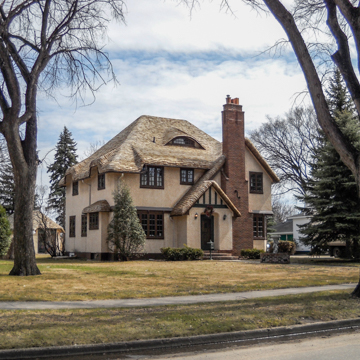Early homes in the southside district were built primarily by and for upper- and middle-class professionals and business leaders. Though impacted by the 1997 flood, the neighborhood has made wise choices about property relocation and new infill designs are sympathetic to the scale and architectural character of the historic neighborhood. An interesting historic feature that can be found in the Near Southside District, and other places in Grand Forks, is the patented paving system marketed as Granitoid, combining crushed granite and Portland cement scored to reflect the appearance of brick pavers.
There is a broad range of architectural styles within this historic district. The Tudor Revival house (1926) at 717 Reeves Drive is a good representative. This stucco and half-timbered residence is notable for its unusual false-thatch roof, with hand-cut cedar shingles replicating thatch, and eyebrow dormer. Shallow projections over the front windows give the illusion of an overhanging upper story that was typical of English Tudor buildings.


